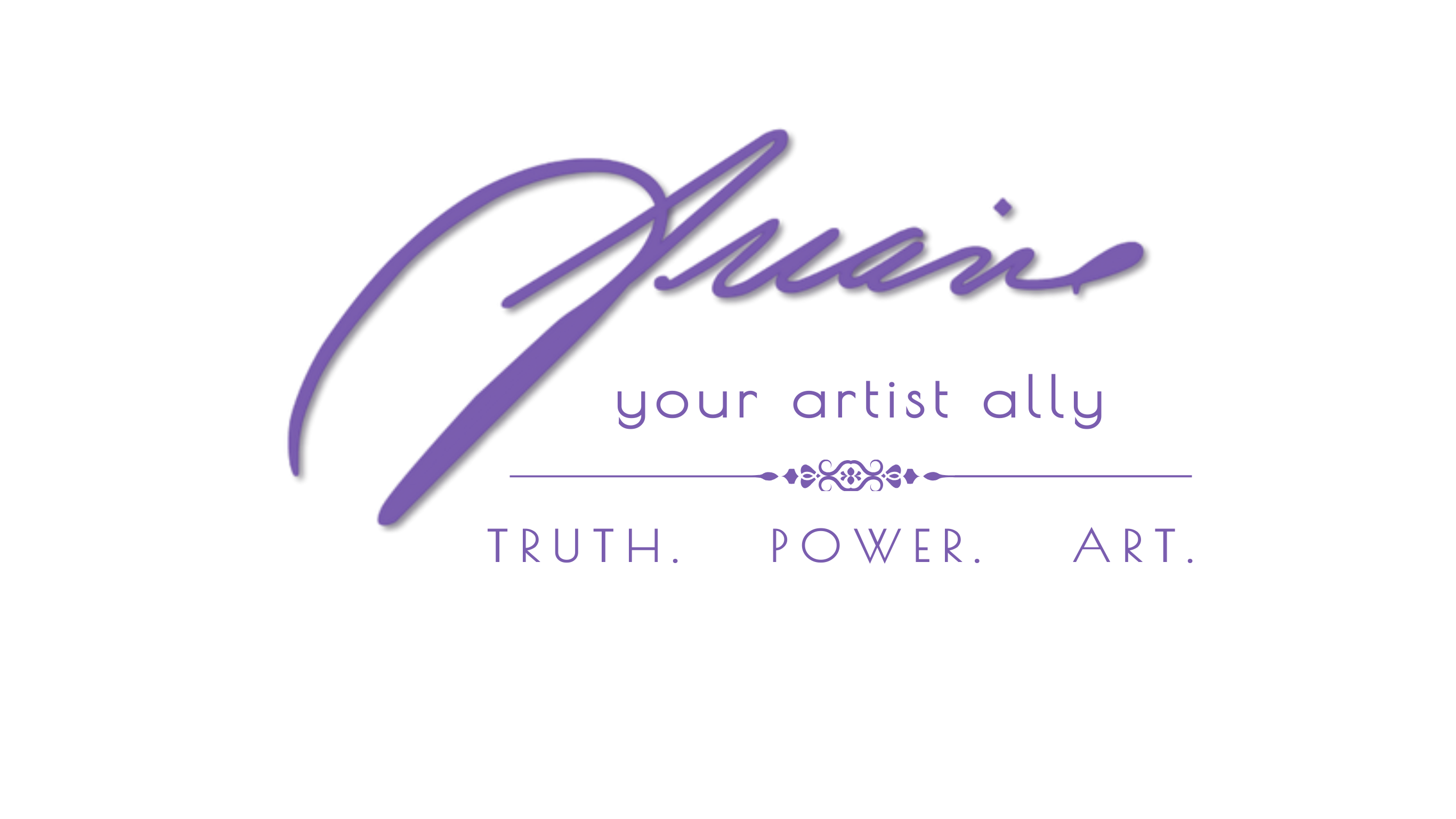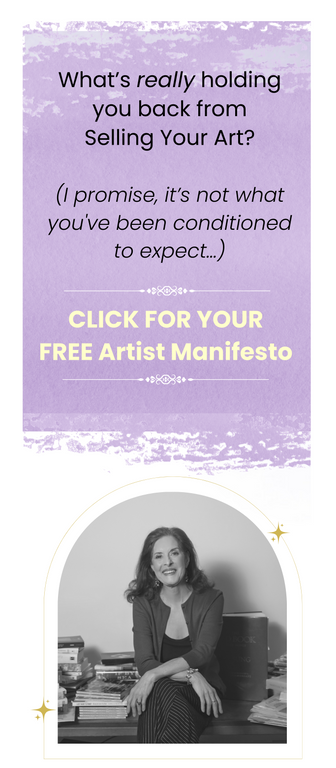It was true in 2002 and it’s just as true in 2024:
The more ways you can reach your artience, the greater your chances for selling your art.
Yes, most likely, your creative strength lies in your visual language, whatever the genre. And words—the language of everyday communication, the language of our culture and family, the language in our thinking minds, the language we depend upon to clarify an image—hold a far more complicated place in our psyches, which I’ll explore in another blog post.
Most of us accompany any visual image with some word-language, even when the visual image is more compelling or dominant.
In fact, the very dominance of visual imagery often seduces us into believing that the visual trumps words, which is why the cliché “a picture is worth a thousand words” is quoted so often. And in my estimation, so thoughtlessly.
What’s important to remember is this: all humans respond to word language, be it verbal, written, or via thought.
And ignoring the power of words to amplify the power of your visual work means you are also ignoring a powerful pathway into the hearts and minds of your artience—the people who love your work and who only need one, extra push to buy it.
The most direct, and most elegant container for words that relate to you and your art is the simple, if challenging, artist statement.
But, where do you begin? What do you need to know before you tackle what I call a grain of sand in an artist’s shoe?
When you’ve read as many truly awful artist statements as I have, it begins to dawn on you that maybe, just maybe, the awfulness starts at the very beginning.
Here’s the most basic question—What the heck is an artist statement?
It turns out you need a definition to start, but there is far more at stake here than just a definition.
For a compelling, engaging artist statement, which truly catches the attention of your viewers instead of making them yawn, here are five major things to keep in mind.
First: Accurately Defining An Artist Statement
When you have an accurate definition, that becomes the very first step in deciding if you’re headed in the right direction or not.
I’ve tracked down ten different sites with ten different ideas about what an artist statement is. And, as far as I can tell, none them really understand three things:
- What an artist statement does for the viewer who is reading it.
- What an artist statement does for the artist who is writing it.
- And how these two trajectories affect each other; both for what is written and for the statement’s final effectiveness.
During my years of one to one coaching, I discovered one of the most confusing aspects of an artist statement is deciding, exactly, what it is.
As I was working with painter, Bob McMurray, I asked if he had an old artist statement we could compare to the one he had just written.
Not really, he said. I wrote some things for a web site, but it’s not an artist statement. I’ve been thinking about writing one for ages, so I was primed and ready to go when I got your book.
Imagine my surprise, when I surfed over, to find a perfectly coherent artist statement on his site. True, a few touch-ups and a stronger central theme would be a plus; and, what he had worked. So, why was this clear to me…
…but not to McMurray, who, after all, wrote the artist statement that he did not think was an artist statement?
It’s Not Obvious, But The Answer Is Simple
Many artists suffer from LOI: Lack Of Information.
If you don’t know what an artist statement is, then how can you be sure that what you’ve written is an artist statement?
When I ask artists to tell me what they think a statement is, one of the most common responses I hear is: I’m supposed to tell my viewer something about my art.
Well, yes, that’s pretty much it in a nutshell… only who is telling you about this nutshell? Is it the hull of a hazelnut? An almond?
When you have a vague definition like this, it becomes subject to a steady stream of individual interpretations, much like the ten websites I just reviewed. Ten different, often vague and disconnected characteristics of an artist statement, but not the deeper purpose of it.
Consider This:
Does An Artist Statement Support Your Art Or Reflect On It?
The problem, when you don’t know exactly what an artist statement is, is that you end up cobbling together a statement out of resumes, biographical statements, and critiques about the artwork and technique. Or, you opt for academic mumbo jumbo.
This usually happens when how you use an artist statement—support material for your art—gets confused with what it is: a very personal reflection on what, how and why you do what you do.
Defining an artist statement has the same benefits as setting a goal: it tells you if you are headed in the right direction. If you don’t know where you are going, then getting there becomes a dicey affair.
You could end up driving aimlessly around for hours. On the other hand, if you establish where you are going, you have a marker for knowing whether or not you have arrived. This single step will save you hours of grief.
So, in case you blew past it a few paragraphs ago, here’s a definition based on your deepest truth that simultaneously holds the power of viewer engagement:
===========================================================
An Artist Statement Definition:
An artist statement is a written, personal reflection on your insights about your relationship to what, how, and why you do what you do—from your perspective as the artist-creator.
===========================================================
Its purpose is to give your artience a peek behind the scenes, to let them have a taste of what your experience, as an artist, is really like.
But wait… there’s more!
Counter Intuitively, It’s Not Just For Your Artience
There’s another side to the artist statement that no one usually articulates: the artist statement is not just for art patrons and gallery owners.
It is also has the capacity to deepen the creativity in your ArtLife.
The very effort of searching for words, which reflects your relationship to your art, increases your creative flow. This is true whenever we engage in a form of self-expression that pushes us out of our comfort zone. Like sweat from physical exertion, the struggle to articulate an artist statement has the added benefit of getting your creative juices flowing.
Writing the Artist Statement focused my connection to my art in a new way. The whole process primed me, gave me a sense of direction.
Now when I’m faced with choosing what to paint out of hundreds of photographs, understanding what moves me, this core place of nostalgia, gives me the reference point I need. ~ R. McMurray, retired Pres. of the Federation of Canadian Arts
As Uncomfortable As It May Feel…It’s About You
We have been conditioned, in so many ways, to feel awkward saying anything complimentary about ourselves. While, conversely, our culture encourages us to make demeaning, belittling self-comments, especially under the guise of humor.
And because an artist statement is so deeply personal—as personal as your art—this tendency toward the Negative Self often pushes us in the opposite direction.
Keep in mind that a good many in your artience think you are magic and if they stand close enough, some of the magic will rub off.
With an artist statement, you give them permission to stand close enough to get a contact magic-high. At its best, an artist statement is honest in the same way that your art is honest. They both reflect a true expression of your being.
When an artist statement speaks from that place of what’s real, then, and only then, will the truth of your statement and your art effortlessly support each other.
Because It’s All About The Personal, Keep This In Mind …
An effective artist statement is as personal as your art. Which is why I insist that artists use first person, I, even though the very thought of writing “I” statements about your art might strike dread into your heart.
It’s very tempting (and artist do it all the time) to write your artist statement in third person because it feels as if that will keep strangers from judging you.
Even though you see artist statements written in the third-person (she/he) all the time, this is never a good idea.
Usually, an artist does this fearing that their statement, and by implication the art, doesn‘t have enough authority to be believed, respected or taken seriously.
Because authorities write about others in the third person, the artist tries to make it sound as if an authority is doing the writing.
But a third-person artist statement becomes easily confused with a critique, and as we have said, an artist statement is not a critique.
Third person also drops the artist statement squarely into a lie, since the artist purposefully sets the reader up to believe that someone else, besides the artist, is doing the writing.
Third person feels more credible, as if some expert wrote all this cool stuff about your work and isn’t that just too neat!
Unfortunately, that removed quality, which third person offers, is exactly what will kill the very reason for an artist statement in the first place: to give your viewer another way to bond with you because now they know something real about you and your art.
The Sticky Factor
An effective statement creates a personal connection to the artwork and stimulates our human thirst for “story.” This, in turn, triggers longer memory storage, and increases the sticky factor about your art, by immersing the viewer in two languages: visual and linguistic.
Writing in prose works best because prose is a friendly, accessible form. Prose lends itself to narration and storytelling, which helps the reader engage with what the artist is saying, which in turn encourages the reader to engage with the art.
Once in a while, poetry or prose-poetry is effective, when an artist is comfortable and skilled enough to pull it off.
The content of a statement is simple: It’s made up of specific words, which the artist chooses, and their construction.
Details Matter
Even if collectors love your work, an artist statement that comes off as arrogant, naïve, pushy, academic, or fluffy taints your artwork by association. Why take the chance?
Your work deserves an artist statement that gives you the professional edge you need.
Even though Artdex’s definition of an artist statement is only partially accurate, this bit of their advice might motivate you: A compelling artist statement can break a tie in an art competition, an artist grant application, or secure your spot in a coveted artist residency program.
And, to help you with the “detail” end of things, here’s one tip I’ll share about compelling writing: always use specific details in place of generalities.
“A tree” becomes “A gnarled oak with one branch blackened from lightening.”
“A sliced orange” becomes “One slice into the skin and the pungent, orange fragrance rose up from the cutting board.”
If you would like a comprehensive understanding of what an artist statement is—and how to leverage the purpose it serves for you and for your artience—alongside a step-by-step process for how to write an artist statement, keep in mind that the learning curve is similar to taking a class in a new technique for your artwork.








